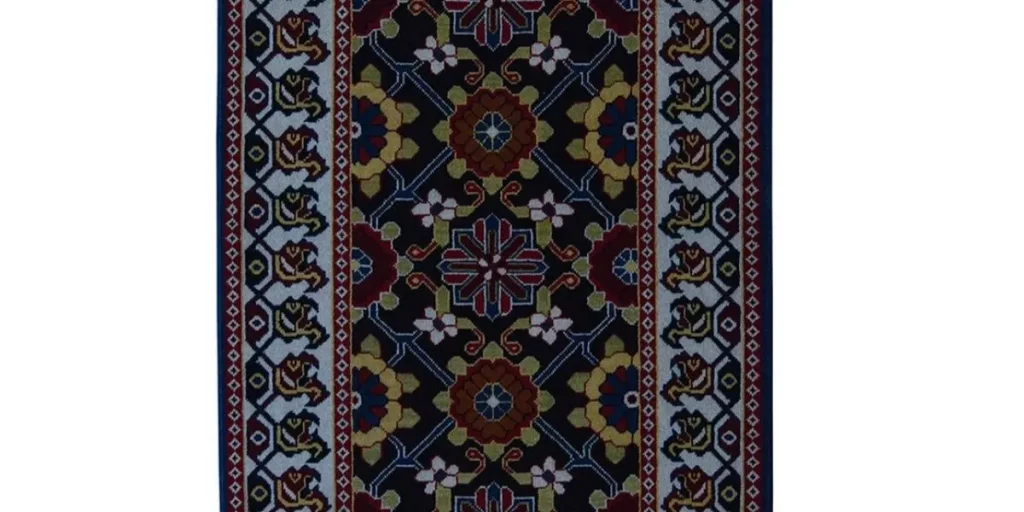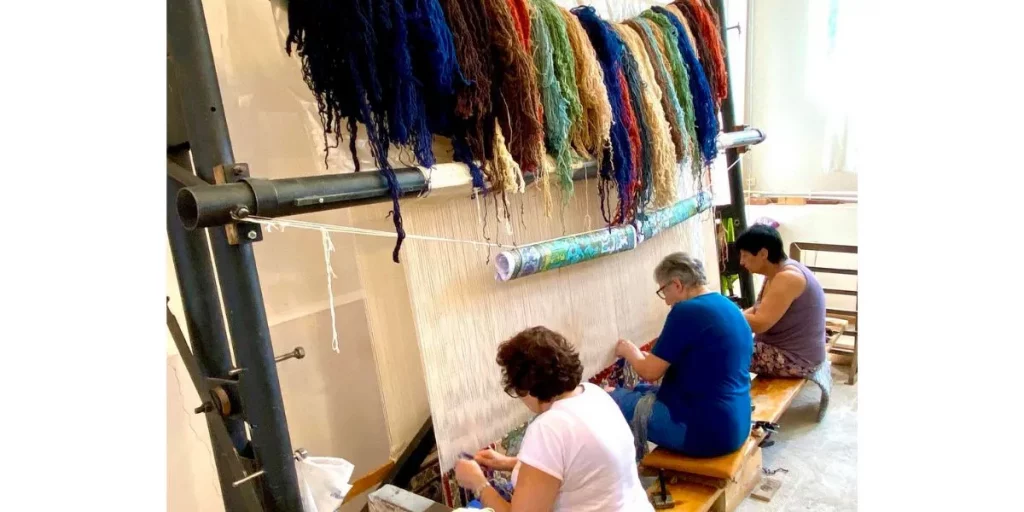Armenian carpets have historically been an integral part of our rich tradition of art and craftsmanship. Armenian carpets stand out as true masterpieces among many treasures of this beautiful country. They have a fascinating history and in this blog post, we will dive into their symbolism, cultural heritage, weaving techniques, and more.
Originating in the Bronze Age, Armenian carpets date back to the 3rd millennium BCE. Evolving over the ages, they feature unique motifs like the Tree of Life, pomegranates, crosses, and dragons, each with symbolic significance. Despite facing challenges, the art of carpet weaving experienced a revival in the 20th century, blending traditional techniques with modern artistry. Today, Armenian carpets stand as cherished treasures in Armenia and abroad.
If you like my blog post, don’t forget to get in touch on Twitter or Instagram with #ArmeniaTravelTips.
Ancient origins of the Armenian carpets
If you went back to the Bronze Age, you could see the ancestors of modern Armenians weaving carpets. This is evidenced by archaeological discoveries. Different excavations in the Anatolia region unearthed remnants of ancient carpets. They were found mainly in burial sites and cave dwellings such as Areni Cave, which I’ll talk more about below. These date back as early as the 3rd millennium BCE. Such explorations prove that carpet weaving was part of the cultural fabric of our ancestors.
For example, excavations have revealed fragments of carpets within burial mounds. They were used as burial shrouds or as items placed within tombs. An important site for archaeological findings is Areni-1 Cave located in the Vayots Dzor region of Southern Armenia (see on the map). If you head here by yourself and ask locals about the location of the cave, keep in mind they might know it as Birds’ Cave rather than Areni-1. Here fragments of well-preserved carpets were found dating back to the 5th-3rd millennia BCE. Today, this of course is a major source of pride for Armenians, and unsurprisingly it’s a popular attraction for travelers.

How Armenian carpet designs evolved
Since Armenians started weaving carpets many centuries ago, the evolution of Armenian carpet designs can be traced across different periods.
In ancient and medieval periods (5th century BCE to 15th century CE), Armenian carpets were characterized by durability rather than intricate artistic patterns. They featured simple motifs, such as crosses, rosettes, and animal figures. Mainly natural dyes were used.
In the Renaissance period (15th to 17th centuries), Armenian carpets were influenced by artistic and cultural movements in Europe and the Middle East. For example, we can see flowers, vines, and arabesques in the carpets of this period, which can also be seen in other parts of the broader region.
In the Ottoman period (16th to 19th century), Armenian fell under the control of the Ottoman Empire. Naturally, we can see many Persian and Turkish influences. Medallions, palmettes, and geometric elements were added.
Contemporary Armenian carpets feature traditional motifs mixed with modern design elements. Technological advances and global sharing of know-how allow for a much richer pallet of solutions both for weaving and dying techniques to be employed these days in Armenia.

Traditional Armenian carpet weaving techniques
The foundation of the Armenian carpets is a technique known as the double-knot technique, also known as Ghiordes rug knot. It is done by tying the wool or silk fibers around two warp threads. With this method, Armenian artisans could create secure and durable rugs. In fact, the Armenian double knot technique is known to be one of the most elaborate and durable in the industry.
Armenian artisans also employed a technique called “warp and weft”. The warp refers to the vertical threads stretched tightly on a loom. The weft is known as horizontal threads interlaced through the warp. This weaving technique is very strong and durable.
What’s interesting is that along with the “double-knot” Armenian carpets employ two different knotting techniques: symmetrical and asymmetrical. They also widely use the symmetrical knot in Turkey. The asymmetrical knot is more widespread in Iran. So, the Armenian carpets incorporated a blend of these techniques, which is clear evidence of the influence of these two empires on us over the course of history.
When it comes to colors, Armenian artisans traditionally used natural dyes and locally sourced materials that they took from plants, minerals, and insects. These dyes are not only durable but add vibrant beauty to the craft.
Today, we can enjoy different variations in carpet weaving in different regions of Armenia, including carpets from Artsakh, Lori, and Syunik. Each of these regions possesses its own characteristic designs and color palettes. So, despite the fact the origins of the carpets can relate to one popular technique in the past, I love seeing that the craft evolved to incorporate local traditions differently everywhere.

Symbolism and cultural significance
Many written histories and heroic tales contain references to the Armenian carpets. Armenian rugs are depicted in historic paintings and mentioned in old books.
Numerous kings of foreign kingdoms even demanded Armenian rugs as an annual “tax” along with mules and other animals. Our Armenian ruling elites often secured the loyalty of the powerful royals in the region by gifting them countless extravagant rugs made by Armenian weavers. So, one cannot underestimate the historic role of Armenian carpets on the faith of my people.
Today, one of the biggest collections of Armenian rugs is owned by the Armenian Apostolic Church. Alongside gold (and expensive cars – I’m not even kidding) the Church keeps a part of its wealth in the form of Armenian carpets. So, in a way, these are kind of collectibles for them, but old Armenians used specific rugs for different traditional and religious ceremonies – weddings, burials, etc.
It’s interesting to note that Armenians wove prayer rugs well before the emergence of Islam in the 7th century. Although they today have association with Islam, I can imagine that its symbolism we might have borrowed from our neighbors in the region as a means of driving both ritualism and discipline among the followers of the religion.

Symbolic motifs in Armenian carpets
So, it’s safe to say that Armenian carpets are not merely decorative items but they carry huge symbolism and cultural meaning in them. While above I looked at the meaning of the carpets themselves in our history and tradition, I wanted to also touch on the topic of the symbolism of what’s on our carpets. Some common motifs of the Armenian carpets include:
Tree of Life: The Tree of Life symbolizes fertility, prosperity, and the interconnectedness of all living beings. It is a parallel symbol to the eternal cycle of life and both frequently appear in Armenian art and crafts, and not just on our carpets.
Pomegranate: you can see pomegranates in many forms of Armenian craftsmanship. It symbolizes abundance, fertility, and good luck. The use of pomegranates as an artistic symbol is prevalent in Armenian art to this day. You can easily see it at Vernissage in Yerevan (art and crafts market), or check out Parajanov’s iconic firm The Colour of Pomegranates.
Cross: Armenians pride themselves on being the first nation to adopt Christianity as the national religion. So, since Christianity made its way into our communities, the symbolism of a cross entered into our arts and craftsmanship, including carpet weaving.
Animals and birds: These traditionally carry different meanings. For example, the eagle symbolizes power and protection. The ram represents strength and masculinity. I can imagine that people would intentionally weave carpets with different animals to communicate certain ideas. Maybe to protect their homes with the spirits of these animals, or maybe even to encourage someone if they gave such carpets as a gift.
Dragons: A very widespread motif in the Armenian carpets is “vishaps” or “dragons”. There is even a name for it “Vishapagorg” or “Dragon Rug”. Dragons are not always an expression of evil or bad in our culture. They signified protection and support. This tradition of weaving “vishapagorgs” is one of the most ancient in Armenian carpet weaving history, it dates back to the 2nd -3rd millennium BC.
Revival of the Armenian carpet weaving
Unfortunately, like many traditional art forms, Armenian carpet weaving faced a decline due to wars, cultural upheaval, and displacement. Especially the atrocities of the beginning of the 20th century and the displacement of my people from the Ottoman Empire brought unprecedented challenges to this once-thriving industry. Many Armenians had to flee their native lands, which meant that many of them couldn’t continue practicing their craft and had to find new ways of providing for their families. A lot of carpets and other forms of art were stolen from our communities as well. So, the craft of carpet weaving suffered a blow at that time.
It was only after the upheavals were over that dedicated individuals embarked on a mission to revive Armenian carpet weaving in the second half of the 20th century. Armenian carpets are an expression of our identity and these individuals clearly understood that. Master weavers, who preserved the knowledge, transmitted it to future generations. Training, resources, and access to the market were provided to learners. This gave a new life to the craft.
Today, Armenian carpet weaving is at its top as traditional techniques go hand in hand with modern art. You can see a lot of pieces in Vernissage and many antique carpet shops in Armenia. If you want to get a piece of this extraordinary art, I am going to give you directions on where you can get them below.

Where to experience and purchase Armenian carpets
Where to see?
If you are looking to buy something other than just want to admire Armenian carpets, you can see them in many museums and galleries across Armenia. For example, you can go to the History Museum of Armenia when in Yerevan. My US-based readers can check out the Armenian Rugs Society in Glendale, California. They showcase select samples of the Armenian rug and textile craft in their galleries, and although I haven’t been there myself, I’ve heard very positive feedback on their collection.
Where to buy?
Armenian carpets are not cheap. So, be prepared to spend some money if you truly value this art. The most accessible way to buy Armenian carpets is going to Vernissage in Yerevan. Here you will find a lot of artists selling their own carpets and rugs. It is also more reasonable to buy here if you like seeing a really wide variety of choices and if you are into bargaining for the price. 🙂
If you find Armenian carpet weaving fascinating, Megerian Carpet Factory in Yerevan is sure to delight you. The factory is one of the cornerstones of the Armenian carpet-weaving revival movement these days. It produces new carpets blended with antique traditional weaving techniques. The best part – for only 3000 AMD (8 USD) you can have a guided tour. You can experience antique pieces of Armenian carpets here. And of course, you can purchase carpets and rugs here as well.
Another super important producer in the contemporary Armenian carpet weaving industry is Tufenkian. They sell carpets both in the USA and in Europe. A truly unique experience is in their location in Yerevan, just opposite Vernissage, in the luxurious Tufenkian Hotel building. Here, when you pass by the hotel, you see massive display windows behind which traditional carpet weavers are at work. I strongly recommend checking them out when you are in Yerevan.
One of the most popular shops selling traditional Armenian carpets is “Antique Carpets”. I have heard that many times from friends when visiting Yerevan. It is located right in downtown Yerevan on Tumanyan St, 32. Not only do they sell a very wide range of contemporary pieces. They also have a decent selection of old carpets. So visit them if you’re looking for something that has a bit of a retro feel to it.

Wrapping up
Exploring and getting one of the rugs is a remarkable experience. And this is true whether you are a passionate collector or simply want to appreciate the beauty of Armenian carpets, . If you are Armenian you may want to get one because you want to be closer to your roots. If you are not Armenian, you may simply appreciate centuries-old craftsmanship that produces high-quality and durable items. Whatever the reason, I think Armenian carpets are a great choice.
If you have read this blog post so far, then Armenian art is of interest to you. I think you might like reading my posts about Armenian duduk history or the 8 facts about Armenian culture. And don’t forget to get in touch on Twitter or Instagram with #ArmeniaTravelTips. Do so if you have some cool carpet pictures to share with me.
Featured image credit: Photo by Sununa on Wikimedia Commons
Please help me make Armenia more popular!





